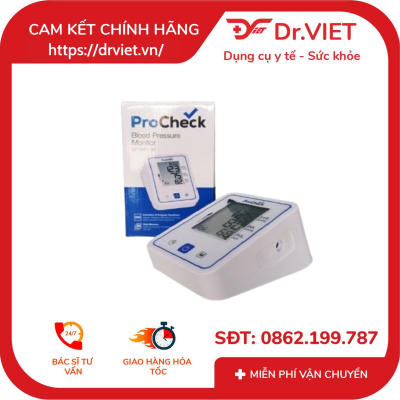THIẾT BỊ Y KHOA Dr.VIET
Thiết Bị Y Khoa Dr.VIET
24/7 – Dr.VIET luôn có ngay để hỗ trợ bạn!
24/7 – Dr.VIET luôn có ngay để hỗ trợ bạn!

Chăm sóc cá nhân
hàng chính hãng - chất lượng - an toàn
GHẾ BÔ VỆ SINH CÓ BÁNH XE LUCASS G-696 – Giải pháp vệ sinh tiện lợi, an toàn ngay tại nhà
✌️✌️ Xin chào quý khách hàng thân yêu! Dr.Viet xin chào ạ! ❤️❤️ Hôm nay, [...]
Đọc tiếpMÁY MASSAGE CẦM TAY DR-88 – PHƯƠNG PHÁP MASSAGE VỚI ÁNH SÁNG HỒNG NGOẠI
✌️✌️ Xin chào quý khách hàng thân yêu! Lại là Dr.Viet đây ạ! ❤️❤️ Hôm [...]
Đọc tiếpMáy massage cầm tay Beurer MG16 – Thư giãn nhẹ nhàng, xua tan mệt mỏi ngay tại nhà
Review Máy Massage Cầm Tay Beurer MG16: “Bảo Bối” Thư Giãn Nhẹ Nhàng, Xua Tan [...]
Đọc tiếpMáy đo huyết áp cơ BOSO BS 90 – Mặt đồng hồ 60 mm
⭐ MÁY ĐO HUYẾT ÁP CƠ BOSO BS 90 – MẶT ĐỒNG HỒ 60MM CHUẨN [...]
Đọc tiếpMáy đo huyết áp điện tử Beurer BM28
Máy đo huyết áp điện tử Beurer BM28 chính hãng và uy tín của Đức [...]
Đọc tiếpMáy Massage ENERGY KING LC-2007AA Chính Hãng – Model LC-2007AA
Máy Massage ENERGY KING LC-2007AA Chính Hãng–Model LC-2007AA –Động Cơ Mạnh, Lực Massage Sâu–Giảm Đau [...]
Đọc tiếpĐèn hồng ngoại Beurer IL21 – Công suất 150W – Hỗ trợ sưởi ấm thư giãn – Thương hiệu Đức
✌️✌️ Xin chào quý khách hàng thân yêu của Dr.Viet! Lại là Y khoa Dr.Viet [...]
Đọc tiếpĐÈN HỒNG NGOẠI BEURER IL11 – Công suất 100W – Chuẩn chất lượng Đức
ĐÈN HỒNG NGOẠI BEURER IL11 – Công suất 100W – Chuẩn chất lượng Đức ✌️✌️ [...]
Đọc tiếpGHẾ BÔ VỆ SINH CÓ BÁNH XE LUCASS G-696 – Giải pháp vệ sinh tiện lợi, an toàn ngay tại nhà
✌️✌️ Xin chào quý khách hàng thân yêu! Dr.Viet xin chào ạ! ❤️❤️ Hôm nay, Công ty Y khoa Dr.Viet [...]
Đọc thêmMÁY MASSAGE CẦM TAY DR-88 – PHƯƠNG PHÁP MASSAGE VỚI ÁNH SÁNG HỒNG NGOẠI
✌️✌️ Xin chào quý khách hàng thân yêu! Lại là Dr.Viet đây ạ! ❤️❤️ Hôm nay, Công ty Y khoa [...]
Đọc thêmMáy massage cầm tay Beurer MG16 – Thư giãn nhẹ nhàng, xua tan mệt mỏi ngay tại nhà
Review Máy Massage Cầm Tay Beurer MG16: “Bảo Bối” Thư Giãn Nhẹ Nhàng, Xua Tan Mệt Mỏi Tại Nhà Mô [...]
Đọc thêmMáy đo huyết áp cơ BOSO BS 90 – Mặt đồng hồ 60 mm
⭐ MÁY ĐO HUYẾT ÁP CƠ BOSO BS 90 – MẶT ĐỒNG HỒ 60MM CHUẨN ĐỨC 1. Giới thiệu sơ [...]
Đọc thêmMáy đo huyết áp điện tử Beurer BM28
Máy đo huyết áp điện tử Beurer BM28 chính hãng và uy tín của Đức Xin chào quý khách hàng [...]
Đọc thêmMáy Massage ENERGY KING LC-2007AA Chính Hãng – Model LC-2007AA
Máy Massage ENERGY KING LC-2007AA Chính Hãng–Model LC-2007AA –Động Cơ Mạnh, Lực Massage Sâu–Giảm Đau Cổ Vai Gáy, Lưng, Chân–2 [...]
Đọc thêmĐèn hồng ngoại Beurer IL21 – Công suất 150W – Hỗ trợ sưởi ấm thư giãn – Thương hiệu Đức
✌️✌️ Xin chào quý khách hàng thân yêu của Dr.Viet! Lại là Y khoa Dr.Viet đây ạ! ❤️❤️ Hôm nay, [...]
Đọc thêmĐÈN HỒNG NGOẠI BEURER IL11 – Công suất 100W – Chuẩn chất lượng Đức
ĐÈN HỒNG NGOẠI BEURER IL11 – Công suất 100W – Chuẩn chất lượng Đức ✌️✌️ Xin chào quý khách hàng [...]
Đọc thêmMáy massage cầm tay Beurer CM50
Máy massage cầm tay Beurer CM50 – Giải pháp làm săn chắc da & giảm sần vỏ cam hiệu quả [...]
Đọc thêmNhiệt kế điện tử OMRON MC-246 – Thiết bị đo thân nhiệt chính xác, an toàn và tiện lợi
Nhiệt kế điện tử OMRON MC-246 là thiết bị đo thân nhiệt chính xác, an toàn và tiện lợi đến [...]
Đọc thêmThảm Massage Beurer MG-280 – Giải pháp thư giãn và chăm sóc cơ thể tại nhà
Thảm Massage Beurer MG-280 – Giải pháp thư giãn và chăm sóc cơ thể tại nhà 1. Giới thiệu tổng [...]
Đọc thêmCân Hành Lý Điện Tử Beurer LS10 – Nhỏ Gọn, Chính Xác, Không Lo Quá Ký Khi Đi Du Lịch!
Cân Hành Lý Điện Tử Beurer LS10 – Nhỏ Gọn, Chính Xác, Không Lo Quá Ký Khi Đi Du Lịch! [...]
Đọc thêmMáy Phun Tinh Dầu Beurer LA30 – Nhỏ Gọn, Chuẩn Công Nghệ Đức
✌️ XIN CHÀO CẢ NHÀ! Máy Phun Tinh Dầu Beurer LA30 GIẢI PHÁP TẠO HƯƠNG THƠM & THƯ GIÃN CHUẨN [...]
Đọc thêmMáy Massage Hồng Ngoại Cầm Tay Beurer MG55 – Giải Pháp Giảm Đau Mỏi, Thư Giãn Cơ Hiệu Quả Tại Nhà Với Công Nghệ Rung Kết Hợp Nhiệt Từ Đức, Thiết Kế Nhỏ Gọn, Bền Bỉ, Phù Hợp Mọi Đối Tượng
🌟Máy massage hồng ngoại cầm tay Beurer MG55– GIẢI PHÁP CHĂM SÓC SỨC KHỎE TẠI NHÀ CHUẨN ĐỨC CHO MỌI [...]
Đọc thêmĐai Massage Bụng Xung Kích Beurer EM37
#️⃣ Đai Massage Bụng Xung Kích Beurer EM37 Xin chào cả nhà! Dr. Viet xin giới thiệu đến bạn [...]
Đọc thêmBăng keo co giãn Carifix Stretch (10cmx10m) siêu đàn hồi, dính chắc, bảo vệ vết thương và cố định băng gạc hiệu quả cho y tế, thể thao, cứu thương, tiện dụng khi di chuyển và đảm bảo an toàn tối đa trong mọi điều kiện khác nhau, phù hợp mọi nhu cầu sử dụng thêm!
Băng keo co giãn Carifix Stretch (10cmx10m) siêu đàn hồi, dính chắc, bảo vệ vết thương và cố định băng [...]
Đọc thêmGối Massage Shiatsu Beurer MG 145 – “Chuyên gia thư giãn chuẩn Đức” cho cổ – vai – gáy ngay tại nhà.
🌟 GIỚI THIỆU Gối Massage Shiatsu Beurer MG 145 – CHUẨN ĐỨC, CHĂM SÓC SỨC KHỎE TẠI NHÀ Xin chào [...]
Đọc thêmGiường Inox y tế 1,2m 1 Tay Quay Có Bánh xe, Thanh chắn, Có bô hoặc không có bô – Giải pháp chăm sóc người bệnh an toàn, bền bỉ và tiện dụng cho mọi gia đình
PHẦN 1: GIỚI THIỆU GIƯỜNG INOX Y TẾ 1,2M 1 TAY QUAY CÓ BÁNH XE, THANH CHẮN, TUỲ CHỌN CÓ [...]
Đọc thêmMáy Xông Khí Dung OMRON NE-C801 Chính Hãng
Máy Xông Khí Dung OMRON NE-C801 Chính Hãng với công nghệ V.V.T, hạt sương siêu mịn, hoạt động êm ái, [...]
Đọc thêmMặt nạ xông mũi họng Omron – mask PVC chính hãng, trẻ em và người lớn.
Mặt nạ xông mũi họng Omron trẻ em, người lớn – Mask PVC. Đối tượng sử dụng: – Gia đình [...]
Đọc thêmMiếng lọc khí dùng cho máy xông khí Omron NE-C801/803/101
Miếng lọc khí dùng cho máy xông khí Omron NE-C801/803/101 XIN CHÀO CẢ NHÀ Hôm nay DR. VIET tiếp tục [...]
Đọc thêmMÁY ĐO HUYẾT ÁP BẮP TAY OMRON HEM-7143T1 – GIẢI PHÁP BẢO VỆ SỨC KHỎE TIM MẠCH CHO MỌI GIA ĐÌNH
MÁY ĐO HUYẾT ÁP BẮP TAY OMRON HEM-7143T1 – GIẢI PHÁP BẢO VỆ SỨC KHỎE TIM MẠCH CHO MỌI GIA ĐÌNH [...]
Đọc thêmMáy đo huyết áp cổ tay Microlife chính hãng – mẫu BP 3BJ1-4D, độ chính xác cao
Máy đo huyết áp cổ tay Microlife BP 3BJ1-4D Ứng dụng công nghệ MAM (tự đo 3 lần) giúp cho [...]
Đọc thêmNhiệt kế điện tử B.Well Swiss WT-04 Standard chính hãng – Đo thân nhiệt nhanh 30–60 giây, đầu mềm chống nước an toàn cho bé và gia đình, độ chính xác ±0.1°C, thiết kế nhỏ gọn bền bỉ, giao hàng toàn quốc, tiện dụng hàng ngày
Nhiệt kế điện tử B.Well Swiss WT-04 Standard – Giải pháp đo thân nhiệt an toàn, chính xác cho cả [...]
Đọc thêmỐNG NGẬM OMRON NE-C28 &NE-C29
ỐNG NGẬM OMRON NE-C28 &NE-C29 ✌️ Xin chào cả nhà! Dr. Viet giới thiệu đến bạn phụ kiện chính hãng [...]
Đọc thêmMiếng lọc khí Omron Chính Hãng (9956271-9) – Phụ kiện máy NE-C28/C29/C900
Miếng lọc khí Omron Chính Hãng (9956271-9) – Phụ kiện máy NE-C28/C29/C900 Xin chào cả nhà! Dr. Viet mang đến [...]
Đọc thêmMáy đo huyết áp Procheck 3UG12P–Giải pháp theo dõi huyết áp
✌️ Xin chào các bạn, Dr. Viet đây! Trong cuộc sống hiện đại, việc theo dõi huyết áp tại nhà [...]
Đọc thêmMáy đo huyết áp tự động Omron HEM-7142T2 Bluetooth chính hãng – công nghệ Intellisense, phát hiện nhịp tim bất thường, cảnh báo cử động khi đo, lưu kết quả trên máy và ứng dụng, dành cho người cao tuổi, người cao huyết áp, theo dõi huyết áp hằng ngày
MÁY ĐO HUYẾT ÁP BẮP TAY OMRON HEM-7142T2 – GIẢI PHÁP BẢO VỆ SỨC KHỎE TIM MẠCH CHO MỌI GIA [...]
Đọc thêmCân điện tử sức khoẻ Omron HN-300T2 – Giải pháp chăm sóc sức khỏe thông minh cho gia đình hiện đại
Cân điện tử sức khoẻ Omron HN-300T2 – Giải pháp chăm sóc sức khỏe thông minh cho gia đình hiện [...]
Đọc thêmMáy đo huyết áp bắp tay Procheck BP 3KD1-3F Chính hãng – Độ chính xác cao đã được kiểm chứng, đo nhanh, chuẩn, cảm biến thông minh, công nghệ đo tiên tiến, lưu trữ lịch sử đo, bảo hành chính hãng, tự động bơm xả, vòng bít êm ái, phù hợp với mọi thành viên trong gia đình, màn hình LCD lớn rõ nét, cảnh báo nhịp tim bất thường, thao tác đơn giản, tiết kiệm pin, hướng dẫn đặt tay đúng, công nghệ đo thông minh
Máy đo huyết áp bắp tay Procheck BP 3KD1-3F Chính hãng – Độ chính xác cao đã được kiểm chứng, [...]
Đọc thêm
Bạn có biết?
Viêm phụ khoa
Nên dùng hằng này để phòng ngừa viêm nhiễm phụ khoa như: nhiễm các loại nấm, viêm/ngứa/rát âm đạo, ra nhiều huyết trắng, khí hư…(Có thể sử dụng phối hợp với phác đồ điều trị: Viêm âm đạo, viêm âm hộ, ngứa âm hộ, huyết trắng…).
Bạn có biết?
Trái cây có nhiều đường
Có một sự thật là trái cây chứa nhiều đường hơn các loại thực phẩm khác: Điều này có nghĩa là bạn nên ăn trái cây với sự kiểm soát để tránh tiêu thụ quá nhiều đường cho cơ thể của mình nhé! Hãy ăn trái cây một cách hợp lý, điều này sẽ rất tốt cho sức khỏe!
Thiết Bị Y Khoa Dr.VIET CAM KẾT
Dr.VIET đang làm mọi điều có thể để duy trì cung ứng sản phẩm và dịch vụ toàn quốc cho khách hàng, ngay cả trong những hoàn cảnh đại dịch COVID – 19 khó khăn này. Giúp bệnh nhân cải thiện sức khoẻ, trải nghiệm tốt nhất khi sử dụng thiết bị mà Dr.VIET cung cấp! Luôn thực hiện mục tiêu là cửa hàng thiết bị y tế Uy tín – Chất Lượng – Hàng Đầu
Thực Phẩm Chức Năng, Dược – Mỹ Phẩm tại Thiết Bị Y Khoa Dr.VIET 100% chính hãng, cam kết hoàn tiền 200% nếu như phát hiện hàng giả kém chất lượng!
24/7 – Dr.VIET luôn có ngay để hỗ trợ bạn!

































